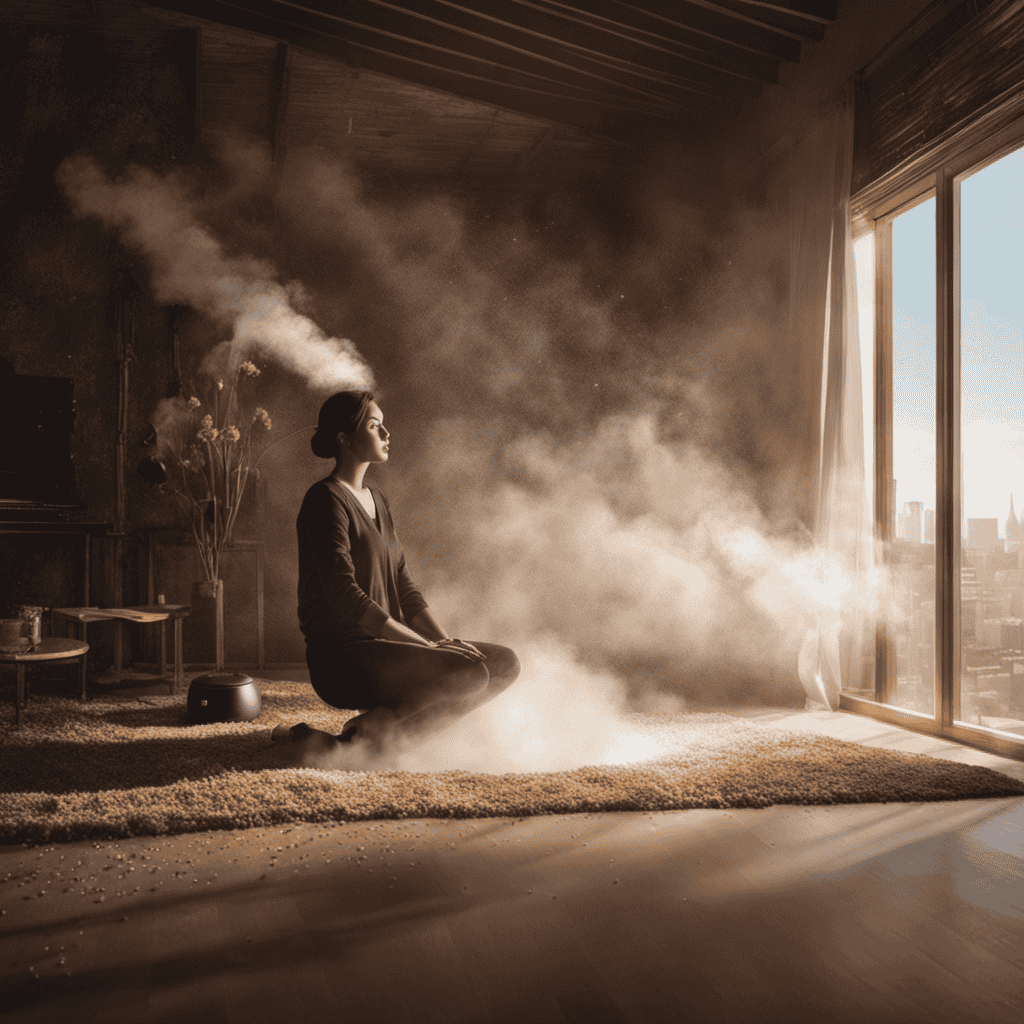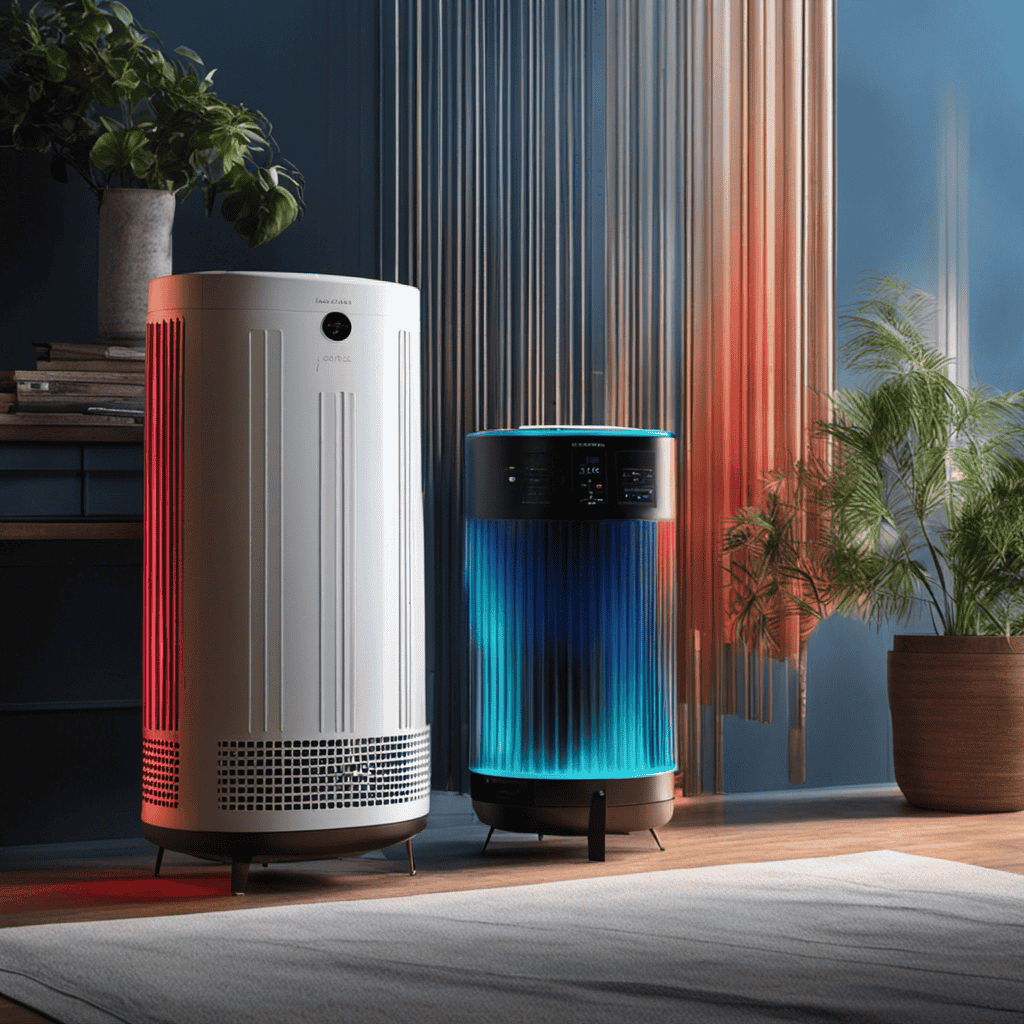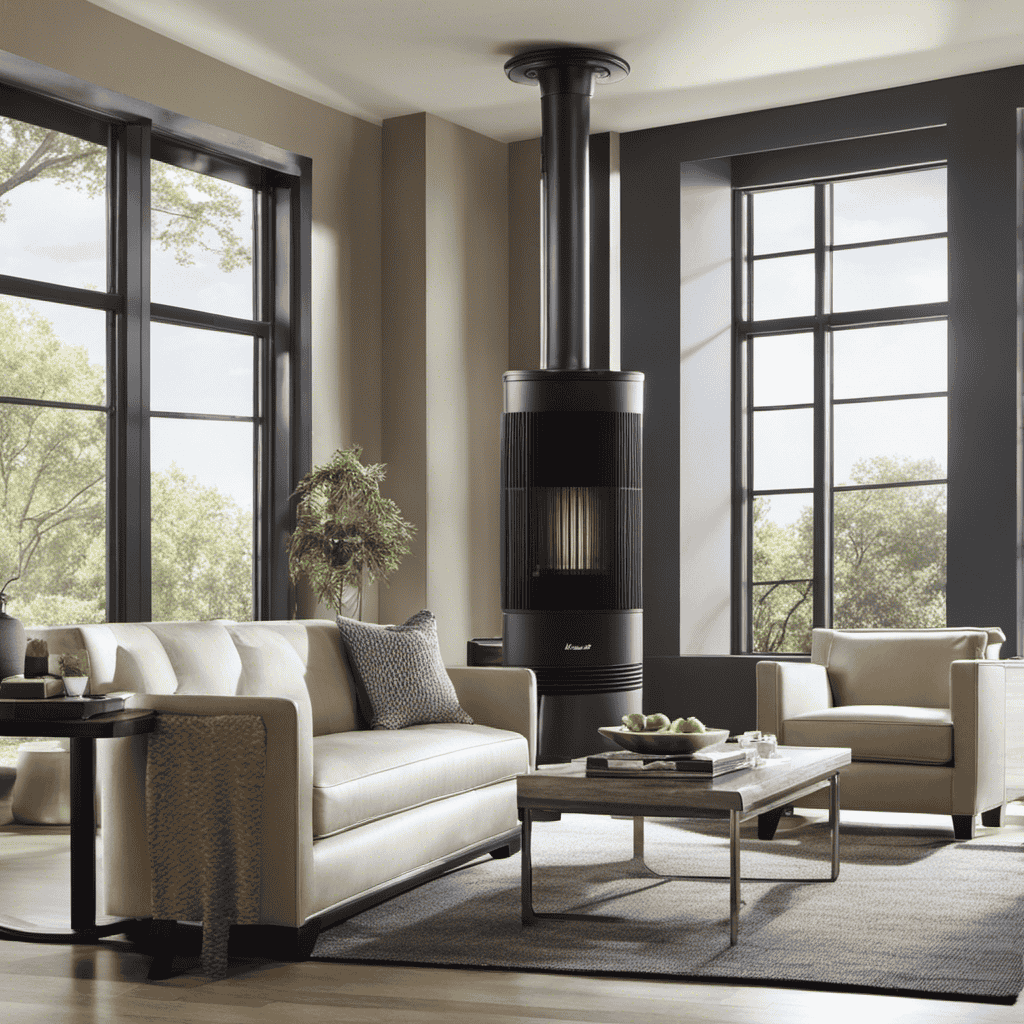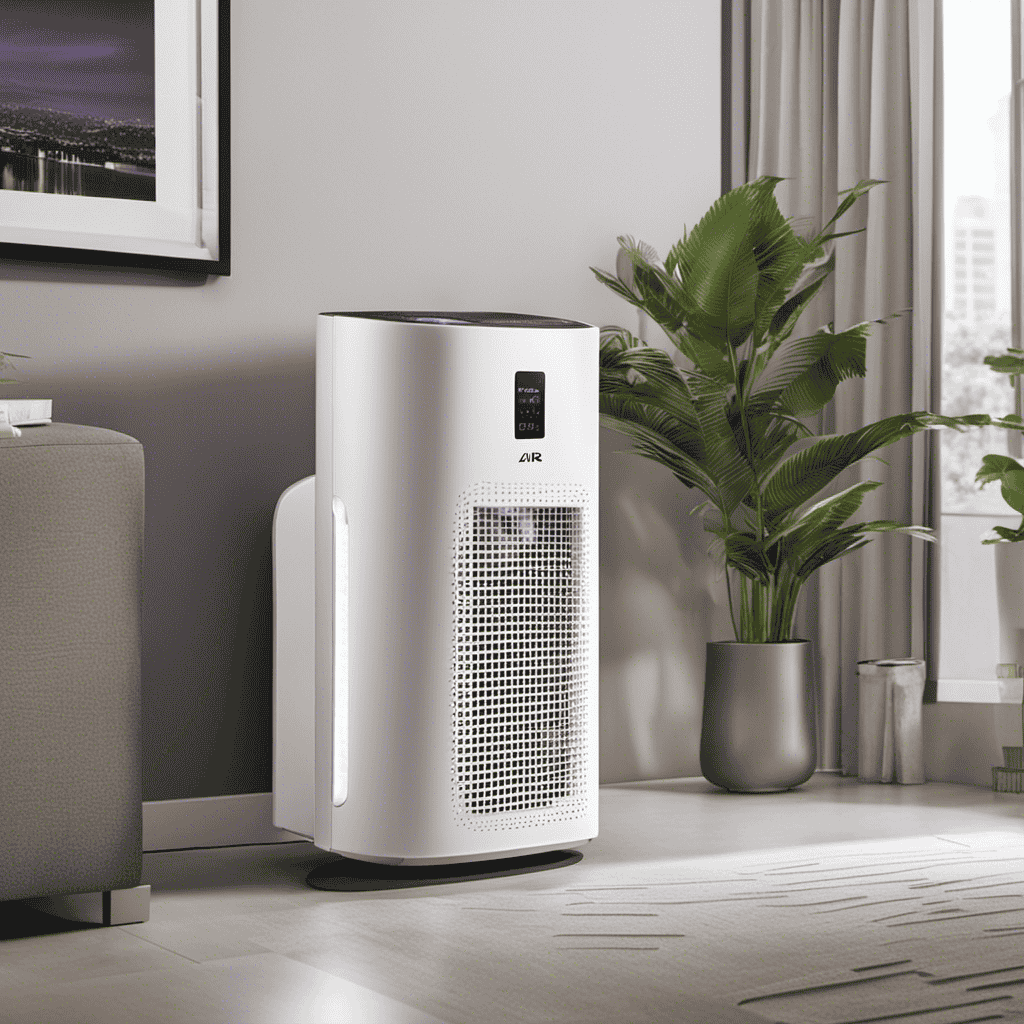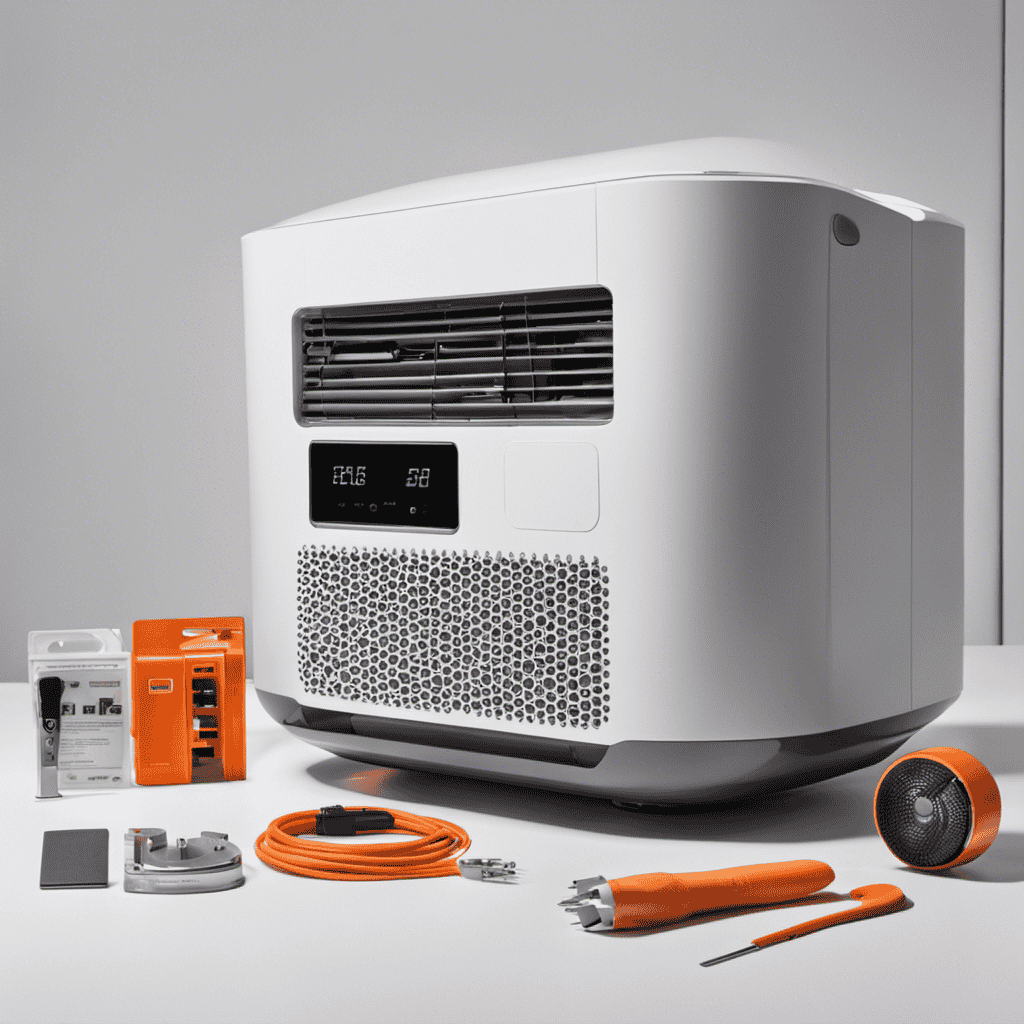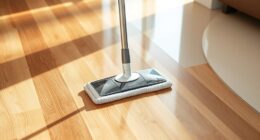As a strong supporter of the significance of clean air, I recently made the decision to purchase an air purifier. I was unaware, though, that these devices could have their own set of side effects.
It got me thinking: what are the potential consequences of using an air purifier? In this article, we will explore the various side effects that can arise from using these machines. From allergies and irritations to ozone emission and chemical exposure, it’s essential to be informed before making a decision.
Let’s delve into the world of air purifiers and uncover the hidden risks.
Key Takeaways
- Limited research on potential health risks
- Effectiveness varies based on factors like room size and pollutants present
- Air purifiers can produce ozone, triggering respiratory symptoms
- Improperly maintained purifiers can accumulate dust and irritate the eyes
Potential Health Risks
There aren’t many studies on the potential health risks of using an air purifier. However, it is important to consider the effectiveness of air purifiers and their possible long-term health effects.
Air purifiers are designed to remove pollutants from indoor air, such as dust, pollen, and pet dander. While they can improve air quality, their effectiveness varies depending on factors like the size of the room and the type of pollutants present.
As for long-term health effects, there is limited research on this topic. Some studies suggest that air purifiers may help reduce symptoms of asthma and allergies. However, it is important to note that air purifiers should not be seen as a standalone solution for improving indoor air quality.
Other measures like proper ventilation and regular cleaning are also essential.
Allergies and Irritations
I have personally experienced the uncomfortable symptoms of respiratory distress caused by allergies. It is not only the sneezing and congestion that bother me, but also the difficulty in breathing and the constant need to clear my throat.
Moreover, I have also noticed that allergies can trigger skin irritations and rashes, adding another layer of discomfort to the mix.
Respiratory Discomfort Caused by Allergies
Allergies can cause respiratory discomfort that may be exacerbated by air purifiers. When allergens such as pollen, dust mites, or pet dander are present in the air, they can trigger an allergic reaction in sensitive individuals. This reaction often leads to symptoms such as sneezing, coughing, wheezing, and shortness of breath. Air purifiers are designed to remove these allergens from the air, but they may not always be effective in providing relief for everyone. In fact, some individuals may experience increased respiratory discomfort when using air purifiers due to the release of chemicals or particles from the purifier itself. To prevent respiratory discomfort caused by allergies, it is important to identify and minimize exposure to allergens, maintain good indoor air quality through proper ventilation, and consider alternative methods of allergen control such as regular cleaning and use of hypoallergenic bedding.
| Causes of Respiratory Discomfort | Prevention of Respiratory Discomfort |
|---|---|
| Allergens in the air | Identify and minimize exposure |
| Chemicals or particles from air purifiers | Maintain good indoor air quality through proper ventilation |
| Regular cleaning and use of hypoallergenic bedding |
Skin Irritations and Rashes
To prevent skin irritations and rashes, you should be mindful of common allergens such as certain fabrics, fragrances, and skincare products. Skin sensitivity is a common issue that can lead to dermatological concerns. Here are some factors to consider in order to maintain healthy and irritation-free skin:
-
Fabrics: Certain fabrics like wool or synthetic materials can cause skin irritation, especially for those with sensitive skin.
-
Fragrances: Many skincare and cosmetic products contain fragrances that can trigger allergic reactions and irritate the skin.
-
Skincare products: Some ingredients in skincare products, such as harsh chemicals or preservatives, can cause skin sensitivities and rashes.
-
Environmental factors: Exposure to extreme temperatures, humidity, or pollution can also contribute to skin irritations.
-
Personal hygiene: Poor hygiene practices, such as infrequent handwashing or using dirty towels, can lead to skin reactions or infections.
Dryness and Skin Issues
I’ve found that using an air purifier may cause allergic reactions in some individuals. This can lead to symptoms such as sneezing, coughing, and difficulty breathing. Additionally, exposure to the purified air can cause eye irritation and redness, which can be uncomfortable and potentially lead to vision problems.
It’s important to be aware of these potential side effects. If they persist or worsen, it’s a good idea to consult with a healthcare professional.
Allergic Reactions From Purifier
Excessive use of an air purifier can sometimes cause allergic reactions in sensitive individuals. It is important to understand the potential side effects of using air purifiers to ensure the well-being of those with allergies. Here are some key points to consider:
- Air purifiers can produce ozone, which can trigger respiratory symptoms in some people.
- Certain types of air purifiers may release harmful chemicals or volatile organic compounds (VOCs) into the air.
- Poorly maintained air purifiers can accumulate pollutants, leading to increased allergic reactions.
- Over-reliance on air purifiers may hinder the development of natural immunity to allergens.
- The effectiveness of air purifiers in reducing allergens depends on factors such as the type of filter used and the size of the room.
Eye Irritation and Redness
After discussing the allergic reactions caused by air purifiers, I will now focus on another possible side effect: eye irritation and redness.
Many people who use air purifiers may experience these symptoms, especially if they have dry eyes or are sensitive to allergens. The reason behind this is that air purifiers can remove moisture from the air, leading to dryness in the eyes.
Additionally, if the purifier is not properly maintained, it can accumulate dust and other particles that can irritate the eyes.
To alleviate these issues, it is recommended to keep the air purifier clean, use a humidifier to add moisture to the air, and consult with an eye doctor if the symptoms persist.
Noise and Disturbance
The noise from air purifiers can be bothersome to some individuals. While these devices are designed to filter out pollutants and improve indoor air quality, they can also contribute to sound pollution and sleep disturbance.
Here are some key points to consider:
- Air purifiers generate noise, ranging from low humming to louder fan sounds.
- The level of noise depends on the type and model of the air purifier.
- Some people may find it difficult to fall asleep or stay asleep due to the noise.
- Sound pollution from air purifiers can be particularly problematic for light sleepers.
- Noise-canceling features or placing the purifier farther away can help minimize the disturbance.
As we explore the side effects of air purifiers, it is important to also address the issue of ozone emission.
Ozone Emission
You should be aware of ozone emission when using an air purifier. Ozone is a gas that can be produced as a byproduct of some air purifiers, particularly those that use ionization or ozone generators. While ozone can help eliminate odors and kill bacteria, it can also be harmful to human health and the environment.
Ozone regulation is in place to limit the amount of ozone that air purifiers can emit. High concentrations of ozone can cause respiratory issues such as coughing, chest pain, and shortness of breath. Additionally, ozone can react with other pollutants in the air to form harmful substances like formaldehyde.
It is important to choose an air purifier that complies with ozone regulations to minimize the environmental impact and potential health risks associated with ozone emission.
Now, let’s discuss another important aspect of air purifiers: chemical exposure.
Chemical Exposure
To minimize potential harm, it’s important to consider the chemical exposure associated with certain types of air purifiers. While air purifiers can be effective in removing pollutants from the air, they can also release harmful chemicals into the environment.
Here are some potential health risks associated with chemical exposure from air purifiers:
-
Volatile Organic Compounds (VOCs): Some air purifiers emit VOCs like formaldehyde, which can cause respiratory irritation and even cancer.
-
Ozone: Certain types of air purifiers produce ozone, which can worsen asthma symptoms and irritate the lungs.
-
Particulate Matter: Some air purifiers release ultrafine particles that can penetrate deep into the respiratory system and cause inflammation.
-
Allergens: If not properly maintained, air purifiers can become breeding grounds for mold, bacteria, and allergens.
-
Chemical Sensitization: Prolonged exposure to certain chemicals emitted by air purifiers can lead to chemical sensitization, causing allergic reactions.
It’s crucial to choose air purifiers that have been tested for safety and effectiveness to minimize the potential health risks associated with chemical exposure.
Maintenance and Upkeep
Regular maintenance and proper upkeep of your air purifier is essential to ensure its optimal performance and prevent potential health risks associated with chemical exposure. Here are some maintenance tips to keep in mind.
-
First, make sure to clean or replace the filters regularly as they can become clogged with dust, pollen, and other particles over time. This will help maintain the efficiency of your air purifier.
-
Additionally, it is important to clean the exterior of the device regularly to remove any accumulated dust or debris.
-
Lastly, don’t forget to check the manufacturer’s instructions for specific maintenance guidelines for your particular model.
By following these maintenance tips and staying on top of filter replacement, you can ensure that your air purifier continues to function effectively, providing you with clean and healthy air.
However, it’s important to note that relying solely on an air purifier can give a false sense of security, as it cannot eliminate all air pollutants.
False Sense of Security
Relying solely on an air purifier can give a false sense of security due to its inability to eliminate all pollutants from the air. Many people have misconceptions about air purifiers and the extent to which they can purify the air. Here are some psychological effects of relying solely on an air purifier:
- Increased anxiety: Believing that the air is completely purified can lead to a sense of anxiety when outside of the purified environment.
- Negligence of other measures: Relying on an air purifier may lead individuals to neglect other important measures, such as proper ventilation and regular cleaning.
- False reassurance: Individuals may falsely believe that they are protected from all pollutants, which can lead to a complacent attitude towards other potential health risks.
- Over-reliance: Depending solely on an air purifier may discourage individuals from seeking out healthier environments or making necessary lifestyle changes.
- Reduced awareness: People may become less aware of the air quality and potential sources of pollution.
Understanding these misconceptions and psychological effects is crucial in order to make informed decisions about air purifier usage. However, it is also important to consider the impact of air purifiers on energy consumption.
Impact on Energy Consumption
Using an air purifier can decrease energy consumption in the long run. Air purifiers are designed to remove pollutants and contaminants from the air, improving indoor air quality. This can have a positive impact on energy efficiency, as cleaner air requires less energy to heat or cool. Additionally, some air purifiers are equipped with energy-saving features such as timers or sensors that adjust the fan speed based on air quality. These features help optimize energy usage and reduce overall consumption.
To illustrate the potential energy savings, consider the following table:
| Air Purifier Model | Energy Consumption (Watts) | Annual Energy Cost ($) |
|---|---|---|
| Model A | 50 | $60 |
| Model B | 25 | $30 |
| Model C | 15 | $18 |
| Model D | 10 | $12 |
| Model E | 5 | $6 |
As shown in the table, choosing a more energy-efficient air purifier can result in significant cost savings over time. Not only does this benefit the household budget, but it also has a positive environmental impact by reducing carbon emissions associated with energy production.
Conclusion
In conclusion, it is important to weigh the pros and cons before deciding to use an air purifier. While they can effectively remove pollutants and improve indoor air quality, there are potential side effects to consider.
From allergies and dryness to noise and chemical exposure, these devices may not be suitable for everyone. It is crucial to properly maintain and use air purifiers to minimize any negative impact.
As the saying goes, ‘every rose has its thorns,’ and air purifiers are no exception.
